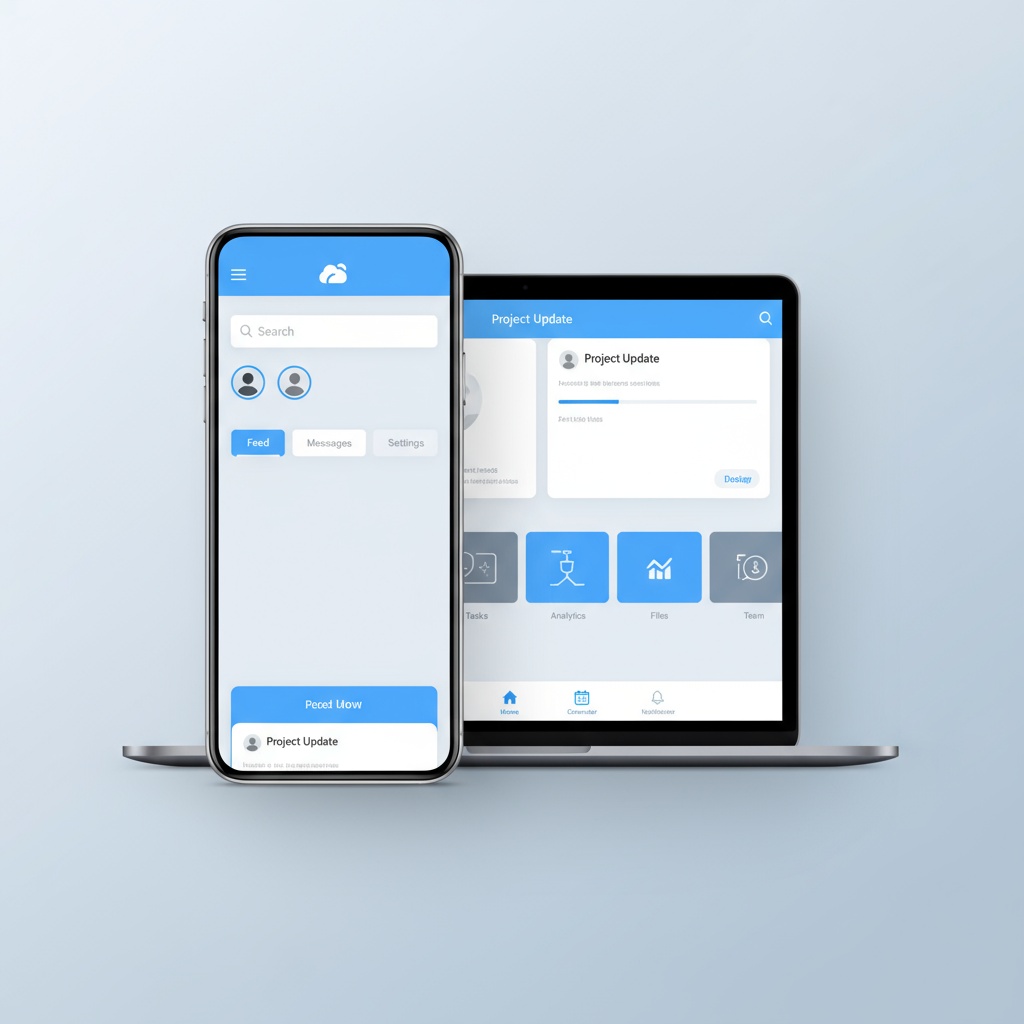Mobile app development has transformed from a niche technical field into the backbone of digital business strategy. With over 257 billion app downloads in 2023 and a market projected to reach $567 billion by 2030, understanding mobile application development is crucial for businesses and developers alike.

What is Mobile App Development?
Mobile app development is the process of creating software applications specifically designed for mobile devices like smartphones and tablets.
This specialized form of application development involves building apps that leverage unique mobile capabilities including touchscreens, cameras, GPS, and device sensors while working within hardware constraints like limited memory and battery life.
The mobile development landscape encompasses three primary approaches: native apps built for specific platforms (iOS or Android), hybrid apps using cross-platform frameworks, and web-based applications accessible through mobile browsers. Each approach serves different business needs and user requirements.
Modern mobile apps development requires understanding both technical implementation and user experience design. Mobile application developers must consider factors like device performance, battery usage, network connectivity, and platform-specific guidelines to create successful mobile applications.
The Mobile App Development Market in 2025
The mobile apps development industry continues its explosive growth trajectory. Users spend approximately 90% of their mobile time within apps rather than mobile browsers, highlighting the critical importance of mobile application development for business success.
Key market insights show that global smartphone users reached 6.92 billion in 2023, representing 86% of the global population. Mobile apps generate over $935 billion in revenue annually, with the average smartphone user having 40+ apps installed. Enterprise mobile app spending increased 23% year-over-year, demonstrating the business value of professional mobile app development services.
The demand for skilled mobile app developers continues rising as businesses recognize mobile applications as essential customer touchpoints. Companies across industries invest heavily in mobile software development to remain competitive and meet evolving user expectations.
Types of Mobile Application Development
Mobile app development is an umbrella term, having multiple branches under it. Let’s explore what’s more in mobile app development and what it means.
Native Mobile App Development
Native app development creates applications specifically for one operating system using platform-specific programming languages and development tools. iOS apps use Swift or Objective-C, while Android applications utilize Java or Kotlin.
Native development offers superior performance and responsiveness, full access to device hardware features, platform-optimized user experience, better security and reliability, and seamless integration with device capabilities.
This approach works best for performance-critical applications, apps requiring extensive device integration, long-term projects with substantial budgets, and applications targeting specific platform audiences.
Cross-Platform Mobile Development
Cross-platform mobile application development enables developers to create apps running on multiple operating systems using a single codebase. Popular frameworks include React Native, Flutter, and Xamarin.
Cross-platform development reduces development time and costs, provides consistent user experience across platforms, enables easier maintenance and updates, offers broader market reach with single development effort, and allows faster time-to-market.
This approach suits startups with limited budgets, MVPs and proof-of-concept applications, content-driven apps, and simple to moderate complexity projects.
Progressive Web Apps (PWAs)
PWAs combine web and mobile app experiences, offering app-like functionality through web browsers while maintaining cross-platform compatibility. PWAs require no app store approval, provide automatic updates, cost less to develop, offer universal device compatibility, and require reduced storage space.
The Mobile App Development Process
There are a plethora of processes around the globe, many of which are based on one generic process, further customized for industry needs and timeline.
Strategy and Planning Phase
Successful mobile application development begins with comprehensive planning involving market research, competitor analysis, target audience identification, and feature prioritization.
This phase includes defining app objectives and success metrics, conducting user research and persona development, analyzing competitor apps and market gaps, creating detailed project roadmap and timeline, and establishing budget and resource requirements.
Design and User Experience
Mobile app design focuses on creating intuitive, engaging interfaces optimized for touch interactions and small screens.
The design phase encompasses wireframing, prototyping, and visual design creation while considering platform-specific design guidelines, responsive design for various screen sizes, accessibility features for inclusive user experience, touch-friendly interface elements, and loading states with error handling.
Development and Implementation
The development phase transforms designs into functional mobile applications. Mobile app developers write code, integrate APIs, implement features, and ensure cross-device compatibility using modular code architecture for maintainability, version control and collaborative development, API integration and backend connectivity, database design and data management, and security implementation with data protection.
Testing and Quality Assurance
Comprehensive testing ensures mobile applications function correctly across devices, operating systems, and usage scenarios. Testing includes functional testing for feature verification, performance testing for speed and responsiveness, security testing for data protection, device compatibility testing, and user acceptance testing for validation.
Deployment and Launch
App deployment involves submitting applications to app stores, managing approval processes, and coordinating launch activities. Launch considerations include app store optimization (ASO) for discoverability, marketing and promotional strategies, user onboarding and support preparation, analytics and monitoring setup, and feedback collection mechanisms.
Maintenance and Updates
Post-launch mobile app development services include ongoing maintenance, feature updates, bug fixes, and performance optimization based on user feedback and analytics. Maintenance activities encompass regular security updates and patches, operating system compatibility updates, new feature development and enhancement, performance monitoring and optimization, and user support with issue resolution.
Essential Skills for Mobile App Developers
There is a certain skillset required to build mobile apps that command the market. Leading mobile app development companies ensure their developers have diverse tech experience, ability to adapt and other technical expertise.
Technical Expertise
Mobile application developers require proficiency in specific programming languages including Swift for iOS mobile application development, Kotlin and Java for Android mobile development, JavaScript for cross-platform frameworks like React Native, and Dart for Flutter cross-platform development.
Essential frameworks and tools include native development SDKs (iOS SDK, Android SDK), cross-platform frameworks (React Native, Flutter, Xamarin), database management systems (SQLite, Core Data, Realm), version control systems (Git, GitHub), and integrated development environments (Xcode, Android Studio).
Professional Skills
Successful mobile application developers combine technical expertise with strong soft skills including problem-solving, communication, teamwork, and adaptability to rapidly evolving technologies. These skills enable effective collaboration with design teams, project managers, and stakeholders throughout the mobile development process.
Mobile App Development Best Practices
Building mobile applications is not the only thing that’s important. Making sure the apps run smoothly, serve the purpose, and survive any attacks and influx of traffic is the true test of app developers.
Performance Optimization
Mobile applications must perform efficiently within device constraints through minimizing app size and memory usage, implementing efficient data loading and caching, optimizing images and multimedia content, reducing network requests and data transfer, and optimizing battery usage.
Security Implementation
Mobile app security protects user data and maintains application integrity through secure data transmission using HTTPS/TLS, local data encryption and secure storage, authentication and authorization mechanisms, input validation and sanitization, and regular security audits with updates.
User Experience Excellence
Superior mobile applications prioritize user experience through intuitive navigation and interface design, fast loading times and responsive interactions, offline functionality for core features, personalization and customization options, and accessibility features for all users.
Choosing Mobile App Development Services in 2025
When selecting mobile app development services, evaluate technical expertise including platform specialization and experience, portfolio quality and diversity, technology stack proficiency, and development methodology with processes.
Consider business factors like communication and project management, timeline and budget alignment, post-launch support capabilities, and industry experience with understanding.
In-house development offers direct control over the development process, better alignment with business objectives, easier communication and collaboration, and long-term team investment. Outsourced development provides access to specialized expertise, cost-effective development options, faster project initiation, and reduced hiring with training overhead.
Mobile Development Trends and Future Outlook
The tech market is changing so rapidly, it is hard to keep up at times. However, there are a few development trends that can make your mobile application top-class.
Emerging Technologies
Modern mobile applications increasingly incorporate artificial intelligence features including machine learning, natural language processing, and computer vision for enhanced user experiences and personalized functionality. Mobile apps serve as control centers for Internet of Things devices, enabling smart home management, wearable device integration, and industrial IoT applications.
Immersive technologies like augmented reality and virtual reality create new possibilities for gaming, education, retail, and social interaction through mobile applications. Low-code and no-code platforms democratize mobile application development, enabling non-technical users to create functional apps while accelerating development for experienced developers.
Network Advancement
High-speed, low-latency 5G networks enable new categories of mobile applications including real-time gaming, video streaming, and IoT applications. These network improvements expand possibilities for developing mobile apps with enhanced performance and new capabilities.
Mobile App Development Costs and Timeline
Mobile application development costs vary significantly based on app complexity and feature set, platform choice (single vs. multiple platforms), development approach (native vs. cross-platform), team location and expertise level, and design requirements with customization.
Simple apps typically cost $10,000 to $50,000, moderate complexity applications range from $50,000 to $150,000, and complex enterprise apps cost $150,000 to $500,000 or more. Development timelines include planning and research (2-4 weeks), design and prototyping (4-8 weeks), development (12-24 weeks), testing and refinement (4-8 weeks), and deployment with launch (2-4 weeks).
Mobile App Marketing and User Acquisition
Effective app store optimization improves app discoverability through keyword optimization in app titles and descriptions, compelling app icons and screenshots, positive user reviews and ratings, regular updates and feature improvements, and localization for international markets.
User acquisition strategies include social media marketing and content creation, influencer partnerships and collaborations, paid advertising campaigns, PR and media outreach, and referral with loyalty programs.
Measuring Mobile App Success
Key performance indicators for mobile applications include user engagement metrics like daily and monthly active users, session duration and frequency, user retention rates, and in-app conversion rates. Business metrics encompass revenue per user, customer acquisition cost, lifetime value, and app store rankings with reviews.
Implement comprehensive analytics to track user behavior, identify improvement opportunities, and measure business impact through tools like Google Analytics, Firebase, and platform-specific analytics solutions.
Common Mobile Development Challenges
Like any other process in the world, mobile development is not without its share of challenges. These range from ideation to design to development to maintenance, yet a few are more critical than others.
Technical Solutions
Address device fragmentation through responsive design, thorough testing, and progressive enhancement strategies. Implement efficient coding practices, optimize resource usage, and conduct regular performance testing across target devices for performance optimization.
Follow security best practices, implement encryption, conduct regular security audits, and stay updated with platform security guidelines.
Business Solutions
Differentiate through unique value propositions, superior user experience, and targeted marketing strategies to handle market competition. Focus on user onboarding, regular feature updates, personalization, and responsive customer support for improved user retention.
Getting Started with Mobile App Development in 2025
For aspiring mobile app developers, the learning path includes choosing a development approach (native vs. cross-platform), mastering relevant programming languages and frameworks, building practice projects and portfolio applications, joining developer communities and forums, and staying updated with platform changes and new technologies.
For businesses developing mobile applications, the strategy involves defining clear app objectives and target audience, choosing appropriate development approach and platform, planning budget and timeline realistically, selecting qualified development team or partner, and preparing for ongoing maintenance and updates.
Conclusion
Mobile app development continues evolving as a critical business capability in our digital-first world. Success requires understanding user needs, choosing appropriate development approaches, and maintaining focus on performance, security, and user experience.
Whether you’re a business exploring mobile application development or an aspiring mobile app developer, the opportunities in this dynamic field continue expanding. The key is starting with clear objectives, learning continuously, and adapting to new technologies and user expectations.
The mobile application development landscape rewards those who prioritize user value, embrace emerging technologies, and maintain commitment to quality throughout the development process.
As mobile devices become increasingly central to daily life and business operations, skilled mobile app developers and well-executed mobile applications will remain in high demand.
Ready to begin your mobile development journey? Start by defining your goals, choosing your platform, and taking the first step toward creating mobile applications that users love and businesses depend on.
Frequently Asked Questions
Here are top questions we get related to mobile app development services.
How long does mobile app development take?
Mobile app development typically takes 4-8 months for a complete project. Simple apps may take 2-4 months, while complex applications can require 6-12 months or more. Timeline depends on app complexity, features, platform choice, team size, and development approach.
What’s the difference between native and hybrid mobile app development?
Native mobile app development creates apps specifically for one platform (iOS or Android) using platform-specific languages like Swift or Kotlin. Hybrid development uses cross-platform frameworks to build apps that work on multiple platforms with a single codebase. Native apps offer better performance, while hybrid apps reduce development time and costs.
Do I need separate apps for iOS and Android?
Not necessarily. You can choose native development for platform-specific apps or cross-platform development to create apps that work on both iOS and Android with a single codebase. Cross-platform solutions like React Native and Flutter enable broader reach with reduced development effort.
What programming languages are used for mobile app development?
Key programming languages include Swift and Objective-C for iOS development, Java and Kotlin for Android development, JavaScript for cross-platform frameworks like React Native, and Dart for Flutter development. The choice depends on your target platform and development approach.
How do I choose between developing a mobile app or mobile website?
Mobile apps offer better performance, offline functionality, device integration, and user engagement. Mobile websites provide broader accessibility, easier updates, and lower development costs. Consider your budget, target audience, required features, and business objectives when choosing.
What’s the mobile app development process?
The mobile app development process includes planning and research, design and user experience, development and coding, testing and quality assurance, deployment to app stores, and ongoing maintenance with updates. Each phase is crucial for creating successful mobile applications.
How do I find reliable mobile app development services?
Evaluate mobile app development services based on technical expertise, portfolio quality, client reviews, development methodology, communication skills, and post-launch support. Consider factors like budget, timeline, project complexity, and whether you need ongoing maintenance services.
What trends are shaping mobile app development in 2025?
Key trends include AI and machine learning integration, IoT connectivity, augmented reality features, 5G network capabilities, progressive web apps, low-code development platforms, enhanced security measures, and voice user interfaces. These technologies are expanding mobile app possibilities and improving user experiences.






